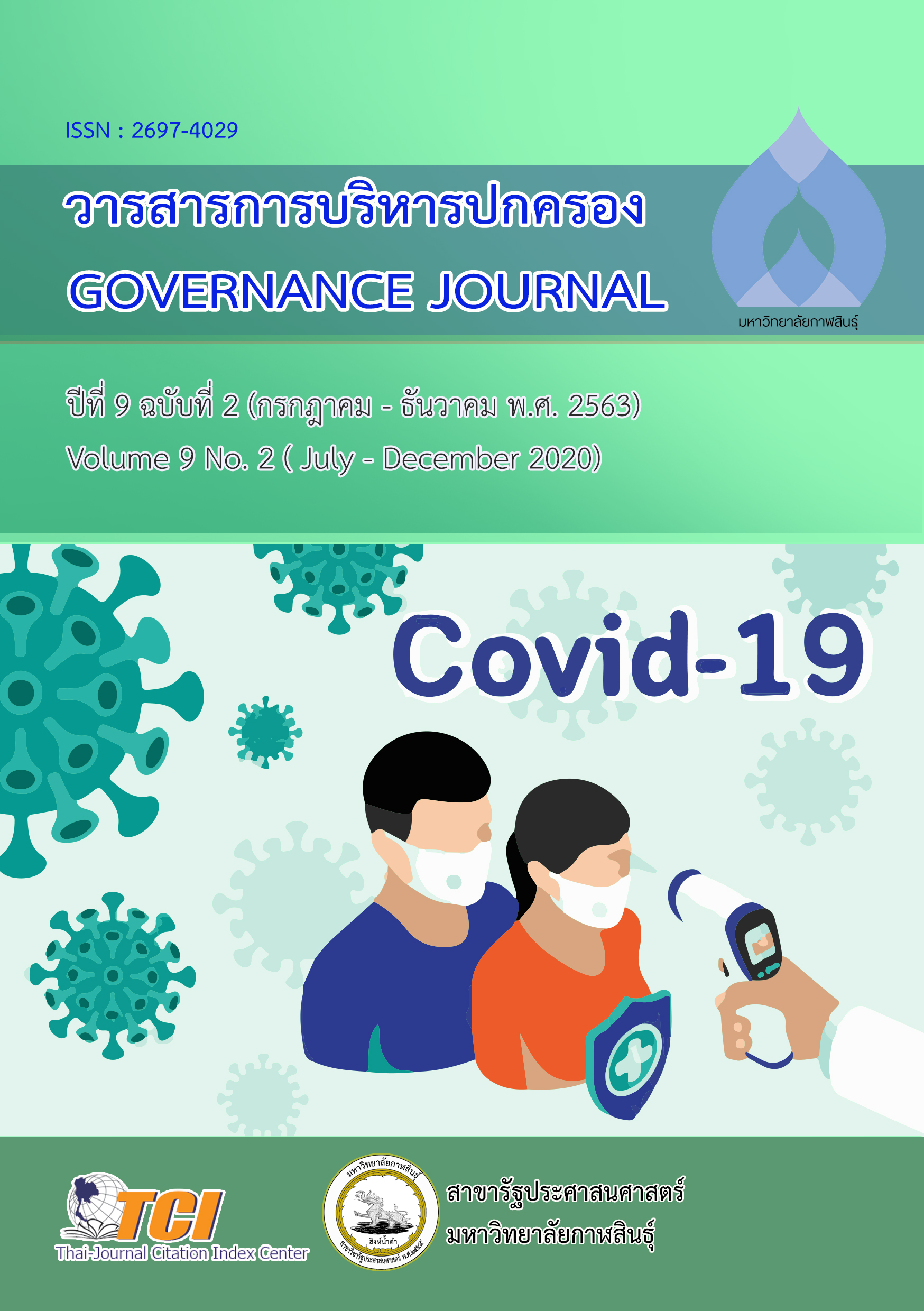ความสัมพันธ์ของปัจจัยต่อการนำองค์ความรู้มาใช้ในการจัดการน้ำท่วมของชุมชนลุ่มน้ำชี-น้ำพอง ในจังหวัดขอนแก่น
DOI:
https://doi.org/10.14456/gjl.2020.25คำสำคัญ:
การจัดการน้ำท่วม, รูปแบบองค์ความรู้, แม่น้ำชี-น้ำพองบทคัดย่อ
การวิจัยนี้มีวัตถุประสงค์เพื่อศึกษา 1) รูปแบบการนำองค์ความรู้มาใช้ในการจัดการน้ำท่วมชุมชนลุ่มน้ำชี-น้ำพองในจังหวัดขอนแก่น และ 2) ความสัมพันธ์ของปัจจัยต่อการนำองค์ความรู้มาใช้ในการจัดการน้ำท่วมชุมชนลุ่มน้ำชี-น้ำพองในจังหวัดขอนแก่น โดยวิธีการเก็บรวบรวมข้อมูลภาคสนามกลุ่มตัวอย่างผู้ประสบภัยน้ำท่วม 28 ชุมชน ใช้แบบสำรวจ แบบสังเกต และการสัมภาษณ์แบบกึ่งโครงสร้างแบบปลายเปิด เพื่อวิเคราะห์ข้อมูลด้านรูปแบบองค์ความรู้และความสัมพันธ์ของปัจจัยต่อการใช้องค์ความรู้ในการจัดการน้ำท่วม ผลการวิจัยพบว่ารูปแบบองค์ความรู้ในการจัดการน้ำท่วมชุมชน มี 3 รูปแบบคือ ประสบการณ์ชุมชน แบบนวัตกรรม และแบบผสมผสาน โดยชุมชนมีรูปแบบการใช้องค์ความรู้เป็นแบบเดี่ยว แบบควบคู่ แบบรวม และบางชุมชนไม่ได้นำองค์ความรู้มาใช้ พบว่าปัจจัยที่ทำให้ชุมชนมีรูปแบบการใช้องค์ความรู้แตกต่างกันคือปัจจัยด้านบริบทชุมชนประกอบด้วย ลักษณะโครงสร้างทางสังคมและที่ตั้งชุมชน และปัจจัยด้านผลกระทบจากภัยพิบัติน้ำท่วมประกอบด้วย ลักษณะการเกิดน้ำท่วม ความเสียหายจากน้ำท่วม ความถี่น้ำท่วม และระยะเวลาน้ำท่วม ซึ่งทั้ง 2 ปัจจัยมีความสัมพันธ์ต่อกัน โดยที่ตั้งชุมชนมีความสัมพันธ์กับผลกระทบจากภัยพิบัติ ลักษณะโครงสร้างทางสังคมและผลกระทบจากภัยพิบัติมีความสัมพันธ์ต่อรูปแบบการใช้องค์ความรู้ในการจัดการน้ำท่วมชุมชน อย่างไรก็ตามการจัดการน้ำท่วมควรใช้ทั้งประสบการณ์ชุมชน นวัตกรรม และการผสมผสานองค์ความรู้เพื่อให้เกิดประสิทธิภาพสูงสุด
Downloads
เอกสารอ้างอิง
กรมป้องกันและบรรเทาสาธารณภัย. (2557). การลดความเสี่ยงจากภัยพิบัติสู่การพัฒนาที่ยั่งยืน. กรุงเทพฯ: กระทรวงมหาดไทย.
กาญจนา แก้วเทพ. (2548). การวิจัย: จากจุดเริ่มต้นถึงจุดสุดท้าย. (พิมพ์ครั้งที่ 1). กรุงเทพฯ: สำนักงานกองทุนสนับสนุนการวิจัย.
กาญจนา ทองทั่ว ชุติมา จันทรมณี และ อุทิศ ทาหอม, (2556). รายงานวิจัยเรื่อง ชุมชนกับการจัดการภัยพิบัติในพื้นที่น้ำท่วมซ้ำซาก. กรุงเทพฯ: สำนักงานกองทุนสนับสนุนการวิจัย.
ณัชนนท์ สนประเสริฐ. (2555). การจัดการความเสี่ยงจากภัยพิบัติโดยอาศัยชุมชนเป็นฐาน. โครงการฝึกอบรม JICA. (ออนไลน์) สืบค้นจาก http://open_jicareport.jica.go.jp/pdf/- 12151627_05.pdf., เข้าถึงเมื่อวันที่ 20 มีนาคม 2560.
พิสมัย ศรีเนตร และ อัญชนา ณ ระนอง. (2561). ทุนชุมชนกับความสามารถของชุมชนในการจัดการภัยพิบัติน้ำท่วม. วารสารการบริหารปกครอง, 7 (1): 522 – 553.
ภาสกร สติชอบ. (2555). การปรับตัวด้านที่อยู่อาศัยในชุมชนพื้นถิ่นที่มีน้ำท่วมซ้ำซาก : กรณีศึกษาบ้านนนทรีย์ ตำบลพุทเลา อำเภอบางปะหัน จังหวัดพระนครศรีอยุธยา. คณะสถาปัตยกรรมศาสตร์. กรุงเทพฯ: จุฬาลงกรณ์มหาวิทยาลัย.
สุวลักษณ์ อะมะวัลย์. (2554). บทวิจารณ์หนังสือ “ธรรมชาติกับวัฒนธรรม และสังคมไทยในกระแสโลกาภิวัตน์”. วารสารการจัดการสิ่งแวดล้อม, 7 (2): 72 – 83.
Burton, I., Kates, R.W., White, G.F., (1978). The Environment as Hazard. New York: Oxford University Press.
Rogers, E. M., & Shoemaker, F. F. (1971). Communication of Innovations; A Cross-Cultural Approach. 2nd Edition, New York: Free Press.
Grenier, L. (1998). Working with indigenous knowledge: A guide for researchers. Ottawa: the International Development Research Centre (IDRC).
Hawley, A. H. (1986). Human ecology: A theoretical essay. Chicago: University of Chicago Press.
Khan, A. R., Khan, A., & Razzaq, S. (2015). Conceptualizing Local Knowledge and Disaster Management. Munich Personal RePEc Archive, (63378). Retrieved from Expanded Academic ASAP database MPRA, March 20, 2015.
Micklin, M. (1973). Introduction: A framework for the study of human ecology. Population, environment and social organization: Current issues in human ecology. Edited by M. Micklin. Hinsdale, Ill.: Dryden Press.
Roy, C., & Andrews, H. A. (Eds.). (2009). The Roy adaptation model. 3rd Edition, Edmonton: Prentice Hall.
Tadashi Nakasu. (2017). Natural Disasters and Disaster Management in Thailand: Status, Risks, and Trends. 13th International Conference on Thai Studies Jul 2017.
Translated Thai References
Amawan, S. (2011). Book Review “Nature and culture and Thai society in globalization. Journal of Environmental Management, 7 (2): p.72 – 83.
Department of Disaster Prevention and Mitigation. (2014). Disaster Risk Reduction to Sustainable Development. Bangkok: Ministry of
Interior.
Kaewthep, K. (2005). Research: from the beginning to the end. Bangkok: The Thailand Research Fund.
Satichob, P. (2012). Housing adaptation in an indigenous community in the repeated flooding area : a case study of Baan Nontree, Putluo Sub-district, Bangphahan district, Pranakornsriayutthaya province. Faculty of Architecture. Bangkok: Chulalongkorn University.
Sonprasert, N. (2012). Community Based Disaster Risk Management
(CBDRM). JICA Training project. Retrieved from http://open_jicareport.jica.go.jp/pdf/- 12151627_05.pdf., March 20, 2017.
Srinate, P. & Na Ranong, A. (2018). Community Capitals and Community
Capacities to Flood Disaster Management. Governance Journal, 7 (1): p.522 – 553.
Thongthua, K., Chantharamanee, C., & Tahom, U., (2013). Research report
of Communities and repetitive disaster management in flood areas. Bangkok: The Thailand Research Fund.
ดาวน์โหลด
เผยแพร่แล้ว
รูปแบบการอ้างอิง
ฉบับ
ประเภทบทความ
สัญญาอนุญาต

อนุญาตภายใต้เงื่อนไข Creative Commons Attribution-NonCommercial-NoDerivatives 4.0 International License.








